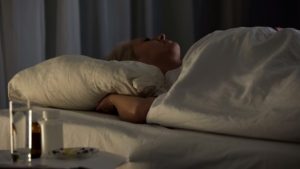 Many people suffer from various sleep disorders that can result in changes to sleep patterns. A sleep disorder can affect overall health, safety, and quality of life, which is why it is so important to keep up to date on new treatments and preventative measures that become available.
Many people suffer from various sleep disorders that can result in changes to sleep patterns. A sleep disorder can affect overall health, safety, and quality of life, which is why it is so important to keep up to date on new treatments and preventative measures that become available.
A sleep disorder that one in five people experience, yet many people don’t know much about, is sleep paralysis. This strange phenomenon is a condition that is thought to explain several mysterious experiences, including alleged cases of demonic night-time visits and alien abduction.
Advertisement
Sleep paralysis is characterized by the inability to move muscles during sleep. It involves paralysis of the skeletal muscles that occurs at the onset of sleep or just before waking. People who experience the phenomenon often report hallucinations, which could be why in Italy, it is referred to as a pandafeche attack. The pandafeche may refer to an evil witch, sometimes a ghostlike spirit or a terrifying catlike creature.
A Connection with Sleep Disorders
Sleep deprivation is thought to be one of the main reasons why sleep paralysis occurs and has been found to be more prevalent in those with psychiatric conditions such as post-traumatic stress disorder. It is also common in those with narcolepsy, a sleep disorder involving excessive daytime sleepiness and sudden loss of muscle control.
Although sleep paralysis has been known for some time, there are no empirically-based treatments or published clinical trials for the condition. However, a team of researchers have recently reported in the journal Frontiers in Neurology a pilot study of meditation-relaxation therapy involving 10 patients with narcolepsy, all of which experience sleep paralysis.
The therapy teaches patients to follow four steps during an episode. These include reappraisal of the meaning of the attack, psychological and emotional distancing, inward focused-attention meditation, and muscle relaxation. The main premise behind the technique is for patients to remind themselves that there is no reason to be afraid and learning how to focus their attention on something positive.
Participants were required to keep a daily journal for four weeks to assess sleep paralysis occurrence, duration, and emotions. Among the ten patients, sixty-six percent reported hallucinations, fifty-one percent upon awakening from sleep, and fourteen percent less frequently upon falling asleep, as rated during the first four weeks.
Advertisement
The study concluded that in the final month of therapy, the number of days patients reported sleep paralysis fell to fifty percent less compared to when the study started. The total overall number of episodes of sleep paralysis also fell to fifty-four percent. There was also a reduction in the disturbance caused by hallucinations.
“Although our study only involved a small number of patients, we can be cautiously optimistic of its success,” said Dr. Jalal from the Department of Psychiatry, University of Cambridge. “Meditation-relaxation therapy led to a dramatic fall in the number of times patients experienced sleep paralysis, and when they did, they tended to find the notoriously terrorizing hallucinations less disturbing. Experiencing less of something as disturbing as sleep paralysis is a step in the right direction.”
Although sleep paralysis isn’t a medical emergency, being familiar with the symptoms can help to provide peace of mind. If the researchers are able to replicate their findings in a larger study, they believe this could offer a relatively simple treatment that could be delivered online or via a smartphone to help patients cope with the condition.
